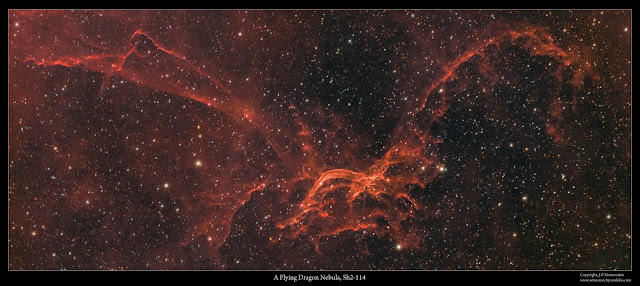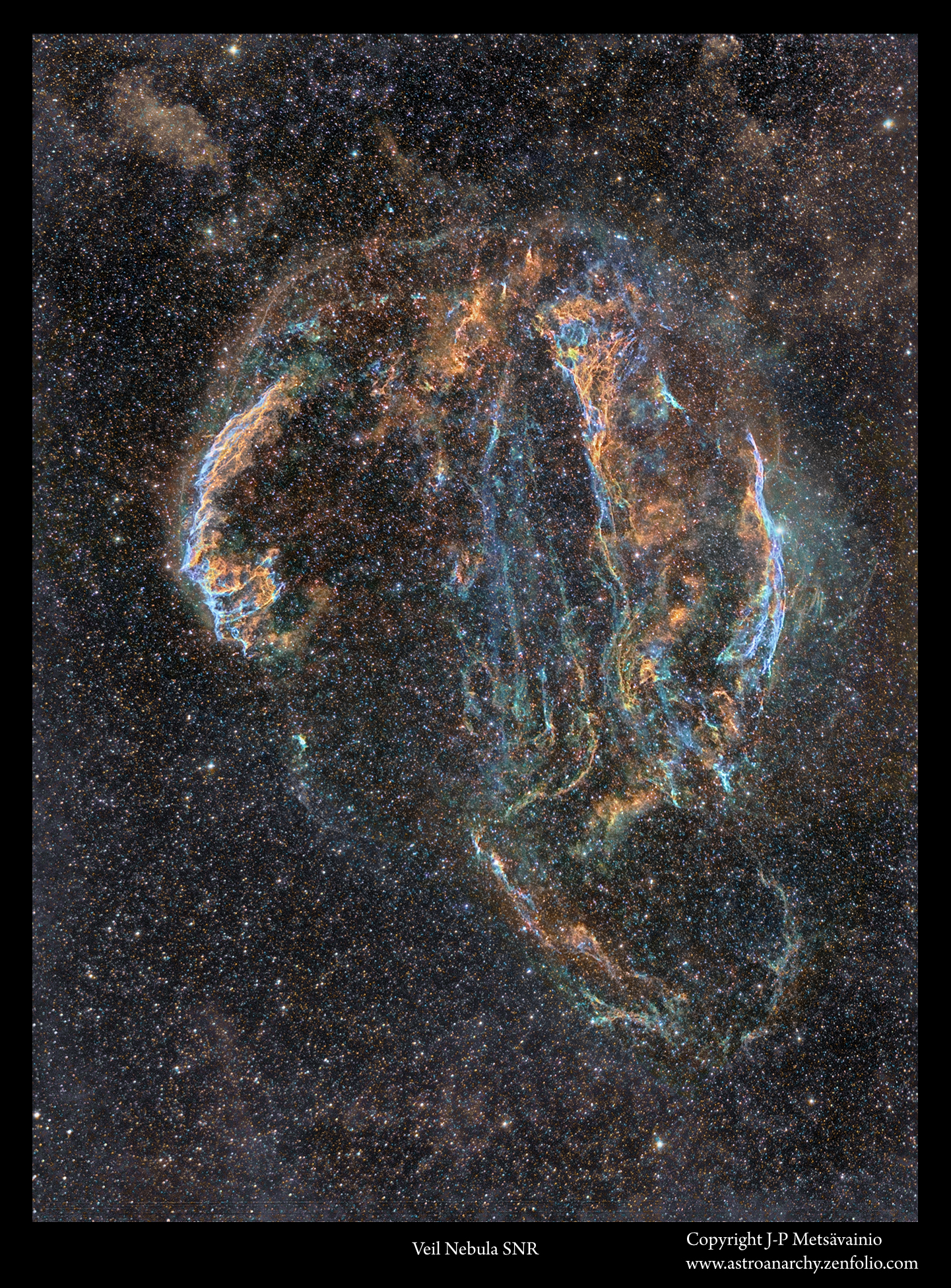COPYRIGHT, PLEASE NOTE
All the material on this website is copyrighted to J-P Metsavainio, if not otherwise stated. Any content on this website may not be reproduced without the author’s permission.
Have a visit in my portfolio
PORTFOLIO:https://astroanarchy.zenfolio.com/
Friday, September 30, 2016
First light for the Autumn season 2016, Eastern part of the Veil nebula supernova remnant.
This is an opening shot for the Spring season 2016, it's good to be back again!
This time I shot a two frame mosaic out of the Eastern part of the Veil Nebula SNR. This image shows well the complex nature of the shock front sourced by an exploded star, a supernova.
Total exposure time from several nights is around 15 hours.
A two panel mosaic of the Eastern Veil Nebula
Please, click for a full size photo, 1850 x 1200 pixels
Image is in mapped colors, from the emission of ionized elements, R=Sulfur, G=Hydrogen and B=Oxygen.
A closeup
Please, click for a full size photo, 1850 x 1200 pixels
Orientation
Please, click for a full size photo
Area of interest is marked as a white rectangle
INFO
Eastern Veil is a part of theVeil Nebula supernova remnant at constellation Cygnus.
Veil Nebula is a cloud of ionized gas and dust, leftovers from an exploded star. The star went off some 5000-8000 years ago at distance of about 1470 light years. The whole Veil Nebula is a relatively faint target and difficult to image due to the large angular diameter, about three degrees, and a dense star field.
Eastern Veil in visual colours
Please, click for a full size photo
Image is in Natural color palette from the emission of ionized elements,
R=Hydrogen + Sulfur, G=Oxygen and B=Oxygen + Hydrogen.
Technical details
Processing work flow
Image acquisition, MaxiDL v5.07.
Stacked and calibrated in CCDStack2.
Deconvolution with a CCDStack2 Positive Constraint, 33 iterations, added at 25% weight
Color combine in PS CS3
Levels and curves in PS CS3.
Imaging optics
Celestron Edge HD 1100 @ f10 with 0,7 focal reducer for Edge HD 1100 telescope
Mount
10-micron 1000
Cameras and filters
Imaging camera Apogee Alta U16 and Apogee seven slot filter wheel
Guider camera, Lodestar x2 and SXV-AOL
Astrodon filter, 5nm H-alpha
Astrodon filter, 3nm O-III
Astrodon filter, 3nm S-II
Exposure times
H-alpha, 9x 1200s = 6h (3h per panel)
O-III, 3 x 1200s binned = 6h (3h per panel)
S-II, 3 x 1200s binned = 3h (1.5h per panel)
Total 15h
Color channels used for the final image
Color channels used for the final image
A single uncropped, calibrated and stretched 20 min. H-alpha frame as it comes from the camera
Labels:
Narrowband color images,
nebula
Tuesday, August 30, 2016
Flash from the past, Cederblad 214, the Cosmic Question mark, reprocessed
The new imaging season will start at 5. of September up here 65N. I have been practising my data processing skills by reprocessing some of my older image data. This time the Cederblad 214 got a new processing. Not a big difference to original processing, little better colors and the detail level is somehow higher.
Cederblad 214, the Cosmic Question Mark
Click for a much large image
Image in mapped colors from ionized elements, Red=Sulfur, Green=Hydrogen & Blue=Oxygen. Image was taken with the Canon camera optics, EF 200mm f.8 full open, QHY9 astrocamera and the Baader narrowband filters. The original blog post from 2012, with technical details, can be seen HERE
A detail
A detail shot from the bright central region of the image at the top. This photo was taken with my new setup, Celestron Edge HD 1100 f7, Apogee Alta U16 astrocamera and the Astrodon narrowband filters, Spring 2014. The original blog post from 2012, with technical details, can be seen HERE
INFO
Source: NASA APOD
Towering pillars of cold gas and dark dust adorn the center star forming region of Sharpless 171. An open cluster of stars is forming there from the gas in cold molecular clouds. As energetic light emitted by young massive stars boils away the opaque dust, the region fragments and picturesque pillars of the remnant gas and dust form and slowly evaporate. The energetic light also illuminates the surrounding hydrogen gas, causing it to glow as an emission nebula. Pictured above is the active central region of the Sharpless 171 greater emission nebula. Sharpless 171 incorporates NGC 7822 and the active region Cederblad 214, much of which is imaged above. The area above spans about 20 light years, lies about 3,000 light years away, and can be seen with a telescope toward the northern constellation of the King of Ethiopia (Cepheus).
Labels:
Narrowband color images,
nebula
Saturday, August 27, 2016
Cinemascope format panoramas from my astro photos
While waiting to image season to start up here, I have worked with a cinemascope format movie theatre presentation from my photos. This is an extra wide ~21:9 format used in movie theaters. The actual film is not ready yet but I have some of my images converted to this ultra wide format. I think they will look great at a large movie screen! I'll publish some of individual panoramic format photos here, images are downscaled for the web.
Cinemascope format image of the Sharpless 114 (Sh2-114)
The Flying Dragon Nebula, in eastern Cygnus, be sure to click for a full resolution version!

Natural color composition from the emission of ionized elements.
More info and the technical details about my photo can be found from HERE
INFO
Sh2-114 is a complex and unusual HII emission nebula. Its complex, wispy structure is likely the result of winds from hot, massive stars interacting with the magnetic fields in the interstellar medium. But very little is known about it. (Source, https://www.noao.edu/image_gallery/html/im1112.html)
Labels:
Narrowband color images,
nebula
Monday, August 22, 2016
Pickering's Triangle reprocessed
This shot about the Pickering's Triangle was my opening image for the Autumn season 2015.
It was also selected for a Astronomy Picture of the Day (APOD) by the NASA.
I'm waiting to new imaging season to start. To practise my astronomical image processing skills, I have reprocessed the whole dataset, about 20 hours of exposures.
Be sure to click for a large image!
The final photo has now better details and little bit more vivid colors. You can see the previous version in the original blog post HERE. Colors are from the ionized elements, Hydrogen, Sulfur and Oxygen. S-II = Red, H-alpha = Green and O-III = Blue.
A closeup
Be sure to click for a large image!
An experimental starless version
Be sure to click for a large image!
Details in this complex supernova remnant are easier to see when the stars are suppressed. It looks kind of spooky too.
The whole two frame mosaic in cinemascope format
Be sure to click for a large image!
A wide field photo shows the whole Veil Nebula supernova remnant
The Pickering's Triangle can be see at one o'clock position.
My blog post about the wide field shot can be seen HERE.
Technical details
Processing work flow
Image acquisition, MaxiDL v5.07.
Stacked and calibrated in CCDStack2.
Deconvolution with a CCDStack2 Positive Constraint, 33 iterations, added at 33% weight
Color combine in PS CS3
Levels and curves in PS CS3.
Imaging optics
Celestron Edge HD 1100 @ f7 with 0,7 focal reducer for Edge HD 1100 telescope
Mount
10-micron 1000
Cameras and filters
Imaging camera Apogee Alta U16 and Apogee seven slot filter wheel
Guider camera, Lodestar x2 and SXV-AOL
Astrodon filter, 5nm H-alpha
Astrodon filter, 3nm O-III
Astrodon filter, 3nm S-II
Exposure times
H-alpha, 15 x 1200s = 5h
O-III, 36 x 1200s binned = 12h (Autumn 2014)
S-II, from my older wide field photo of the Veil Nebula = 3h
Total 20h
Labels:
Narrowband color images,
nebula
Subscribe to:
Posts (Atom)






















